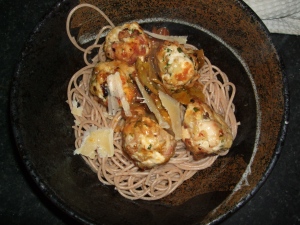I’ve been struggling to find anything I wanted to write about, lately. I’ve been eating out a bit too much – just last week, I had five spice braised beef brisket and the best ma-po tofu at Sojo, amazing sushi (as always) at Edamame, an OK smoked haddock macaroni cheese at The Red Lion and salmon with caponata at a little pub near my parents’ (owned by Deborah Mitford!). Which is all well and good, but since I don’t really do restaurant reviews it doesn’t leave me much to work with. And I love eating out – in fact, as the evidence suggests, I find it nigh on impossible to resist an invitation to eat out – but I’m never happier than when I’m in my kitchen with a jotted list of recipes to try out and full cupboards and plenty of time. So, thank you Bill Granger. Thank you for bringing me back to kitchen harmony with these excellent light and juicy meatballs. I thought I had meatballs pretty much covered, but it turns out what I was missing was something paler, with a delicate touch of chilli and a heavier smack of bacon. And, the chance to use my own homegrown multicoloured cherry tomatoes, which always makes me feel very smugly domestic.
Spicy chicken meatballs
Serves 2
Now, this recipe calls for chicken mince, which is not so readily available. Unless you have your own mincer (I wish I did) you have a few options: 1) ask a friendly butcher to mince some chicken for you; 2) substitute turkey mince, which has the bonus of being cheap and stocked in most supermarkets; 3) what I did, which was to buy some chicken, chop it roughly and pulse it in the food processor. Don’t go too far, texture is a good thing. I used a breast and a thigh, but obviously you can use light or dark meat as you prefer.
2-3 tbsp olive oil
1/2 onion, finely chopped
1 garlic clove, crushed
1/2 tsp ground coriander
1/2 chilli, deseeded and thinly sliced (or one, if you like it hotter)
250-350g minced chicken (see notes above)
2 tbsp breadcrumbs
25g smoked pancetta, chopped small
2 tbsp chopped parsley
250g cherry tomatoes
125ml chicken stock
to serve:
pasta (Bill suggests wholewheat fusilli, I used spelt spaghetti)
parmesan shavings
Heat a tablespoon of oil in a saucepan and fry the onion and garlic over a medium heat until softened. Add the coriander and chilli and cook for a further minute.
Mix together the chicken mince, breadcrumbs, pancetta, parsley and onion mixture. Season well, pinching off a small amount of the mix and frying it in the saucepan to test the seasoning. When you’re happy with the taste, refrigerate the bowl for 30 minutes to firm up. Heat the oven to 200c.
When cold, roll the mixture into small meatballs – around 8-10 – and place on a baking tray. Drizzle with oil. Put the tomatoes on a second tray, drizzle with the remaining oil and season with salt and pepper. Roast the meatballs and tomatoes in the oven for 15-20 minutes, until the tomatoes are starting to split and the meatballs are golden brown. In the meantime, you can start getting the pasta ready.
Put the stock and tomatoes back in the saucepan, add the meatballs and simmer for 5 minutes. It occurred to me that it might be nice to add a splash of wine as well at this point, if you had some open.
Spoon the meatballs and sauce over the pasta and shave some parmesan over the top.
Adapted from Bill Granger’s ‘Every Day’






